DODGE JOURNEY 2010 1.G Owners Manual
Manufacturer: DODGE, Model Year: 2010, Model line: JOURNEY, Model: DODGE JOURNEY 2010 1.GPages: 512
Page 381 of 512
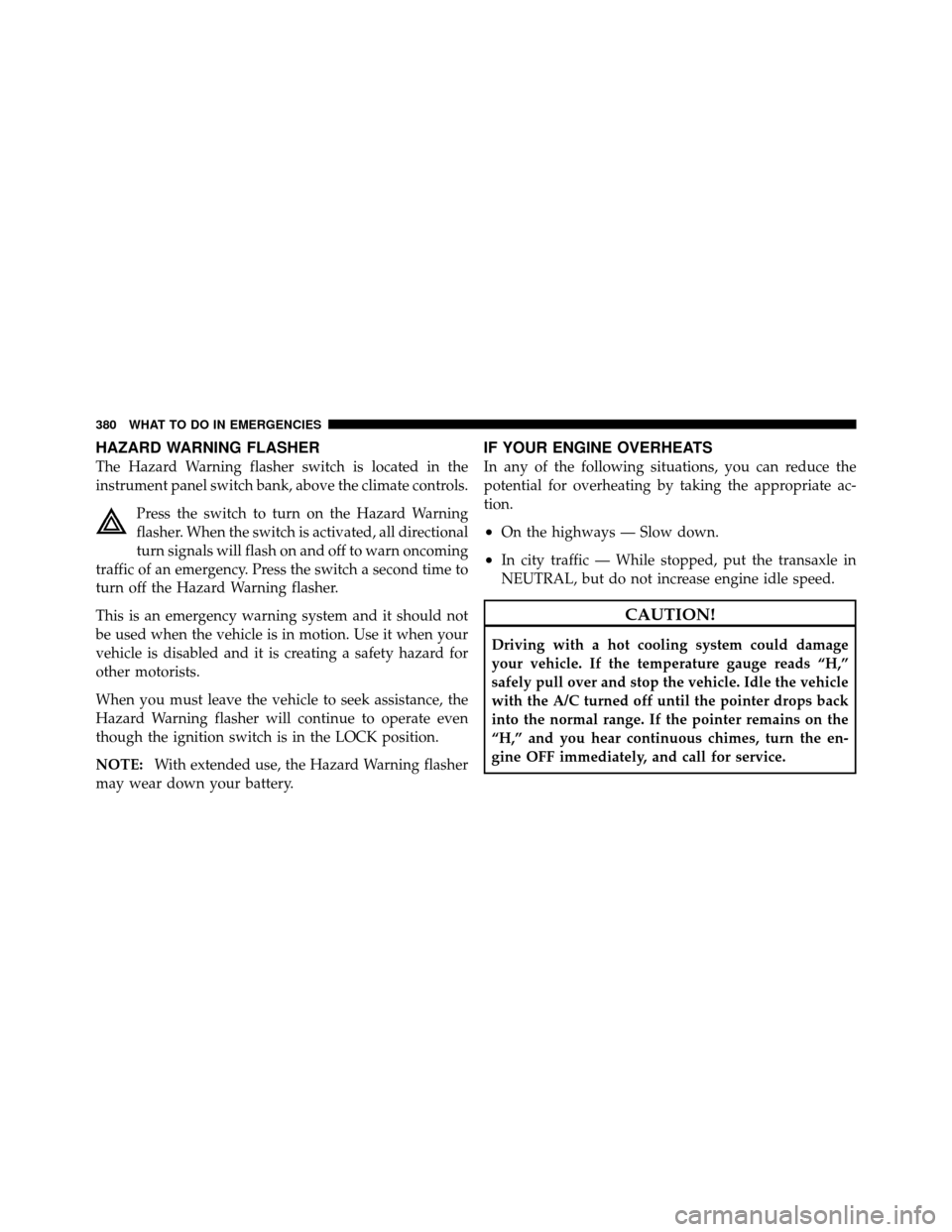
HAZARD WARNING FLASHER
The Hazard Warning flasher switch is located in the
instrument panel switch bank, above the climate controls.Press the switch to turn on the Hazard Warning
flasher. When the switch is activated, all directional
turn signals will flash on and off to warn oncoming
traffic of an emergency. Press the switch a second time to
turn off the Hazard Warning flasher.
This is an emergency warning system and it should not
be used when the vehicle is in motion. Use it when your
vehicle is disabled and it is creating a safety hazard for
other motorists.
When you must leave the vehicle to seek assistance, the
Hazard Warning flasher will continue to operate even
though the ignition switch is in the LOCK position.
NOTE: With extended use, the Hazard Warning flasher
may wear down your battery.
IF YOUR ENGINE OVERHEATS
In any of the following situations, you can reduce the
potential for overheating by taking the appropriate ac-
tion.
•On the highways — Slow down.
•In city traffic — While stopped, put the transaxle in
NEUTRAL, but do not increase engine idle speed.
CAUTION!
Driving with a hot cooling system could damage
your vehicle. If the temperature gauge reads “H,”
safely pull over and stop the vehicle. Idle the vehicle
with the A/C turned off until the pointer drops back
into the normal range. If the pointer remains on the
“H,” and you hear continuous chimes, turn the en-
gine OFF immediately, and call for service.
380 WHAT TO DO IN EMERGENCIES
Page 382 of 512
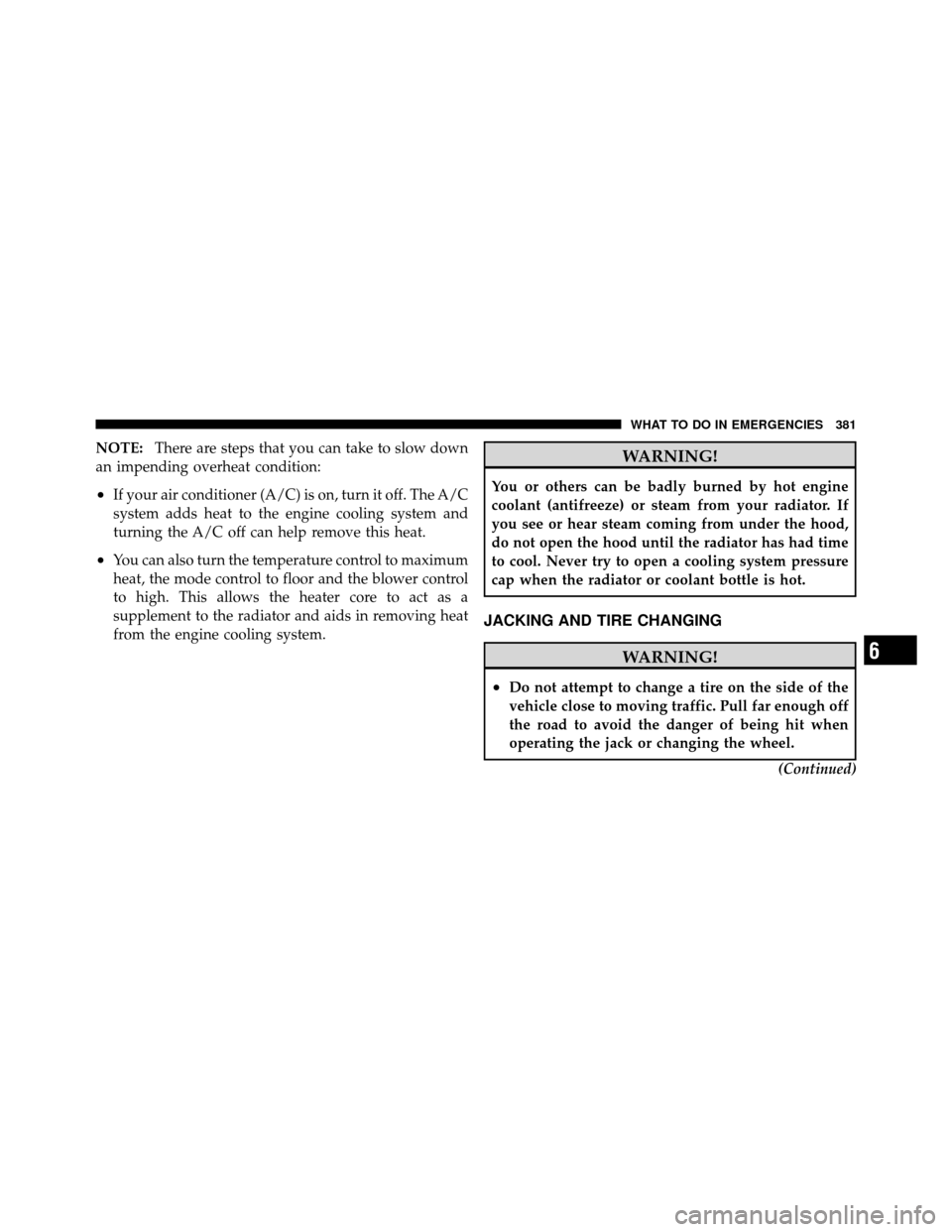
NOTE:There are steps that you can take to slow down
an impending overheat condition:
•If your air conditioner (A/C) is on, turn it off. The A/C
system adds heat to the engine cooling system and
turning the A/C off can help remove this heat.
•You can also turn the temperature control to maximum
heat, the mode control to floor and the blower control
to high. This allows the heater core to act as a
supplement to the radiator and aids in removing heat
from the engine cooling system.
WARNING!
You or others can be badly burned by hot engine
coolant (antifreeze) or steam from your radiator. If
you see or hear steam coming from under the hood,
do not open the hood until the radiator has had time
to cool. Never try to open a cooling system pressure
cap when the radiator or coolant bottle is hot.
JACKING AND TIRE CHANGING
WARNING!
•Do not attempt to change a tire on the side of the
vehicle close to moving traffic. Pull far enough off
the road to avoid the danger of being hit when
operating the jack or changing the wheel.
(Continued)
6
WHAT TO DO IN EMERGENCIES 381
Page 383 of 512
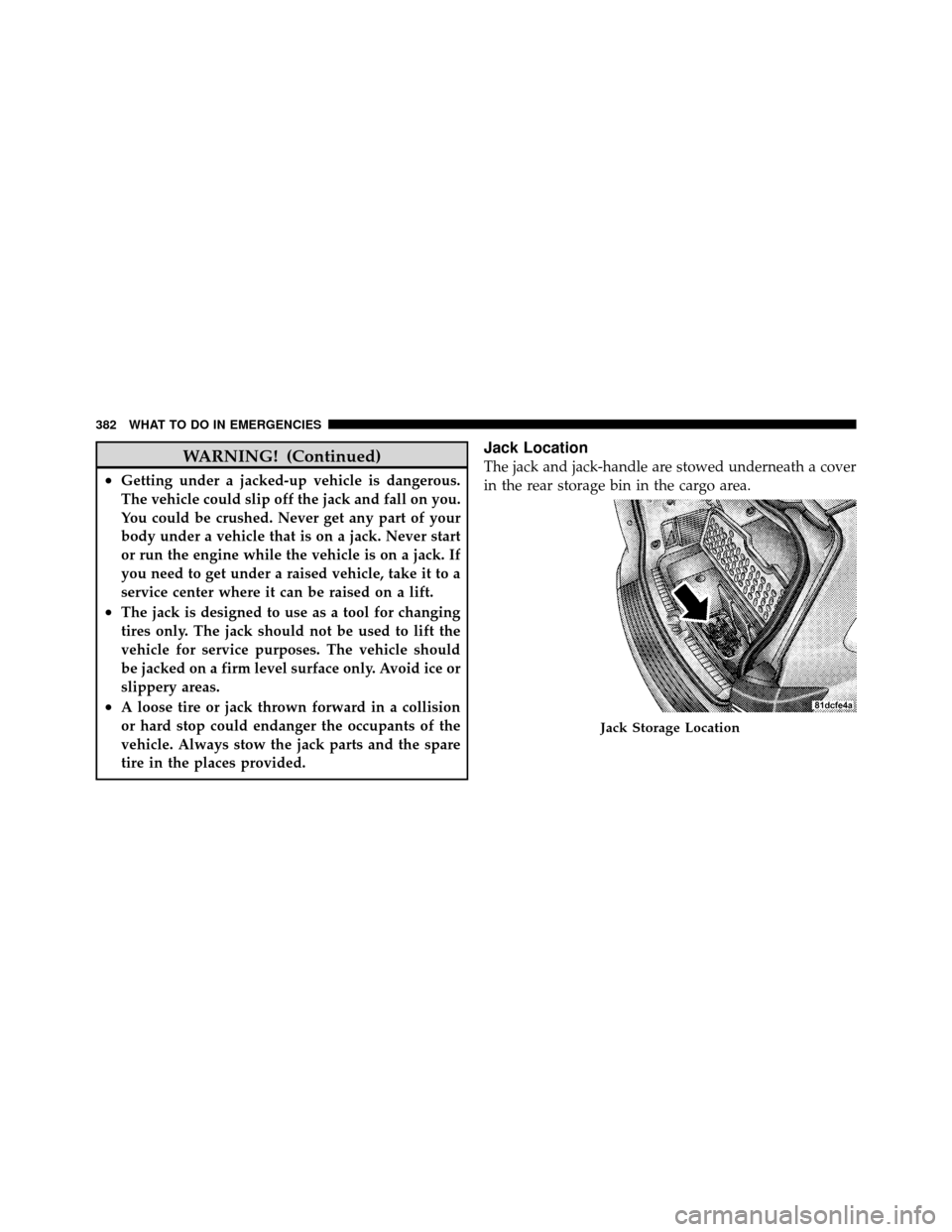
WARNING! (Continued)
•Getting under a jacked-up vehicle is dangerous.
The vehicle could slip off the jack and fall on you.
You could be crushed. Never get any part of your
body under a vehicle that is on a jack. Never start
or run the engine while the vehicle is on a jack. If
you need to get under a raised vehicle, take it to a
service center where it can be raised on a lift.
•The jack is designed to use as a tool for changing
tires only. The jack should not be used to lift the
vehicle for service purposes. The vehicle should
be jacked on a firm level surface only. Avoid ice or
slippery areas.
•A loose tire or jack thrown forward in a collision
or hard stop could endanger the occupants of the
vehicle. Always stow the jack parts and the spare
tire in the places provided.
Jack Location
The jack and jack-handle are stowed underneath a cover
in the rear storage bin in the cargo area.
Jack Storage Location
382 WHAT TO DO IN EMERGENCIES
Page 384 of 512
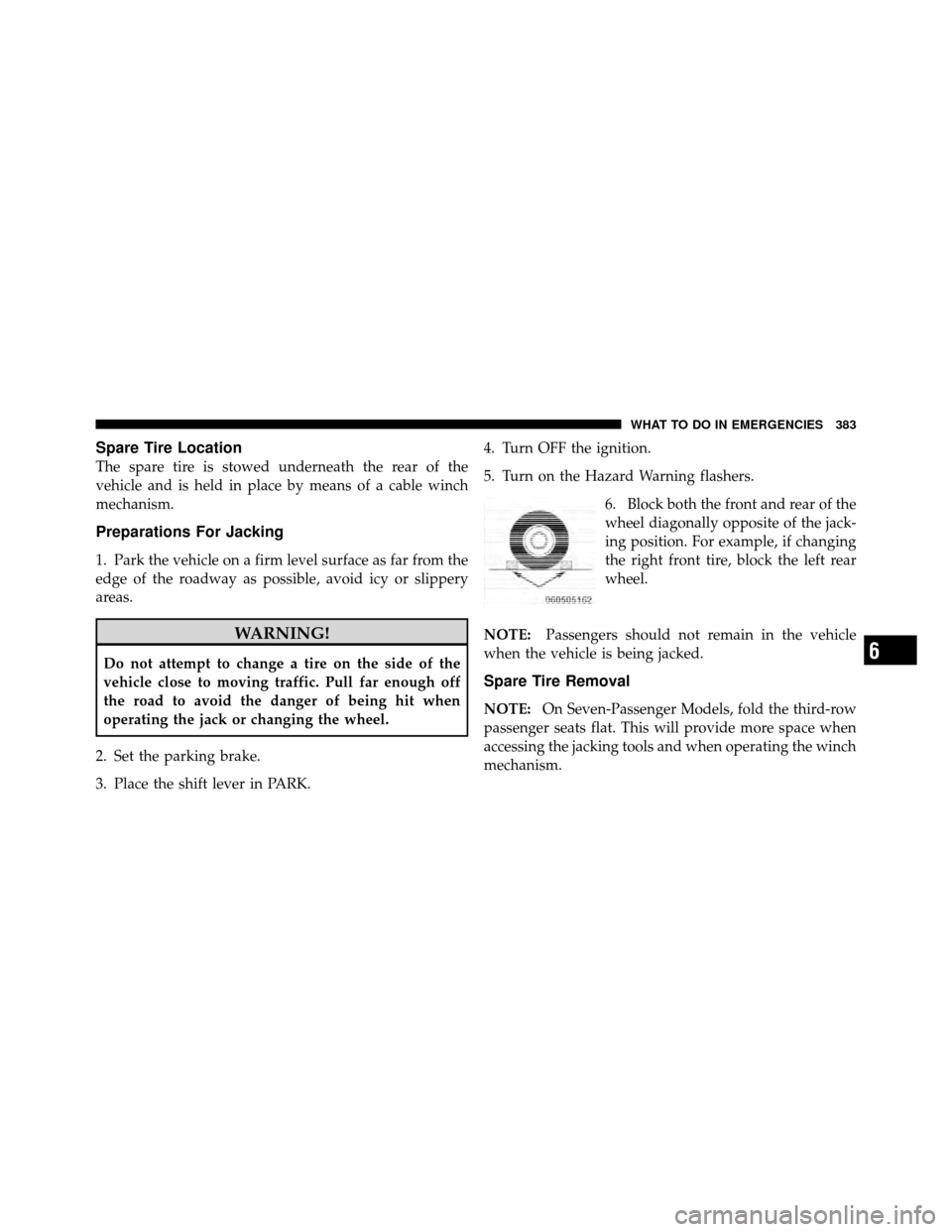
Spare Tire Location
The spare tire is stowed underneath the rear of the
vehicle and is held in place by means of a cable winch
mechanism.
Preparations For Jacking
1. Park the vehicle on a firm level surface as far from the
edge of the roadway as possible, avoid icy or slippery
areas.
WARNING!
Do not attempt to change a tire on the side of the
vehicle close to moving traffic. Pull far enough off
the road to avoid the danger of being hit when
operating the jack or changing the wheel.
2. Set the parking brake.
3. Place the shift lever in PARK. 4. Turn OFF the ignition.
5. Turn on the Hazard Warning flashers.
6. Block both the front and rear of the
wheel diagonally opposite of the jack-
ing position. For example, if changing
the right front tire, block the left rear
wheel.
NOTE: Passengers should not remain in the vehicle
when the vehicle is being jacked.
Spare Tire Removal
NOTE: On Seven-Passenger Models, fold the third-row
passenger seats flat. This will provide more space when
accessing the jacking tools and when operating the winch
mechanism.
6
WHAT TO DO IN EMERGENCIES 383
Page 385 of 512
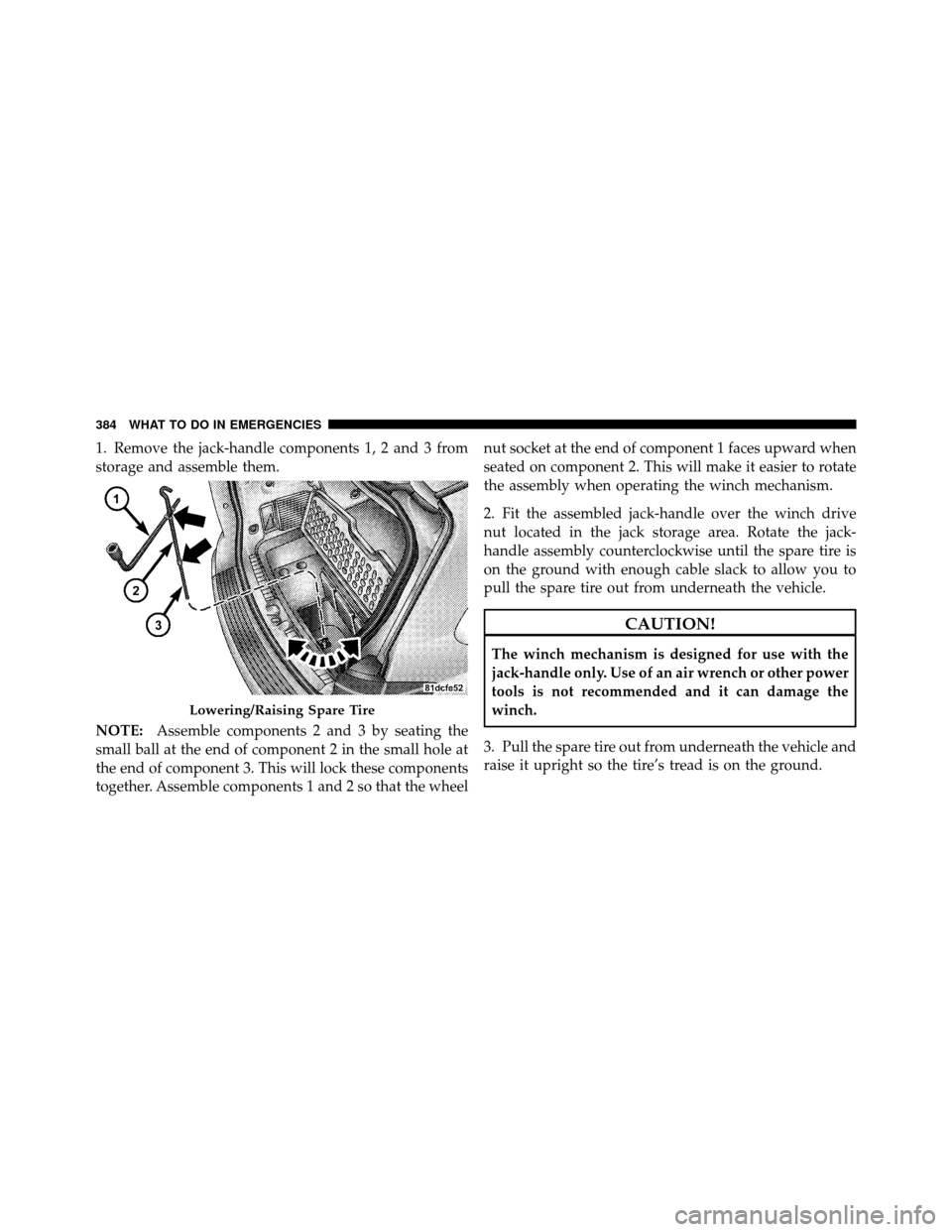
1. Remove the jack-handle components 1, 2 and 3 from
storage and assemble them.
NOTE:Assemble components 2 and 3 by seating the
small ball at the end of component 2 in the small hole at
the end of component 3. This will lock these components
together. Assemble components 1 and 2 so that the wheel nut socket at the end of component 1 faces upward when
seated on component 2. This will make it easier to rotate
the assembly when operating the winch mechanism.
2. Fit the assembled jack-handle over the winch drive
nut located in the jack storage area. Rotate the jack-
handle assembly counterclockwise until the spare tire is
on the ground with enough cable slack to allow you to
pull the spare tire out from underneath the vehicle.
CAUTION!
The winch mechanism is designed for use with the
jack-handle only. Use of an air wrench or other power
tools is not recommended and it can damage the
winch.
3. Pull the spare tire out from underneath the vehicle and
raise it upright so the tire’s tread is on the ground.
Lowering/Raising Spare Tire
384 WHAT TO DO IN EMERGENCIES
Page 386 of 512
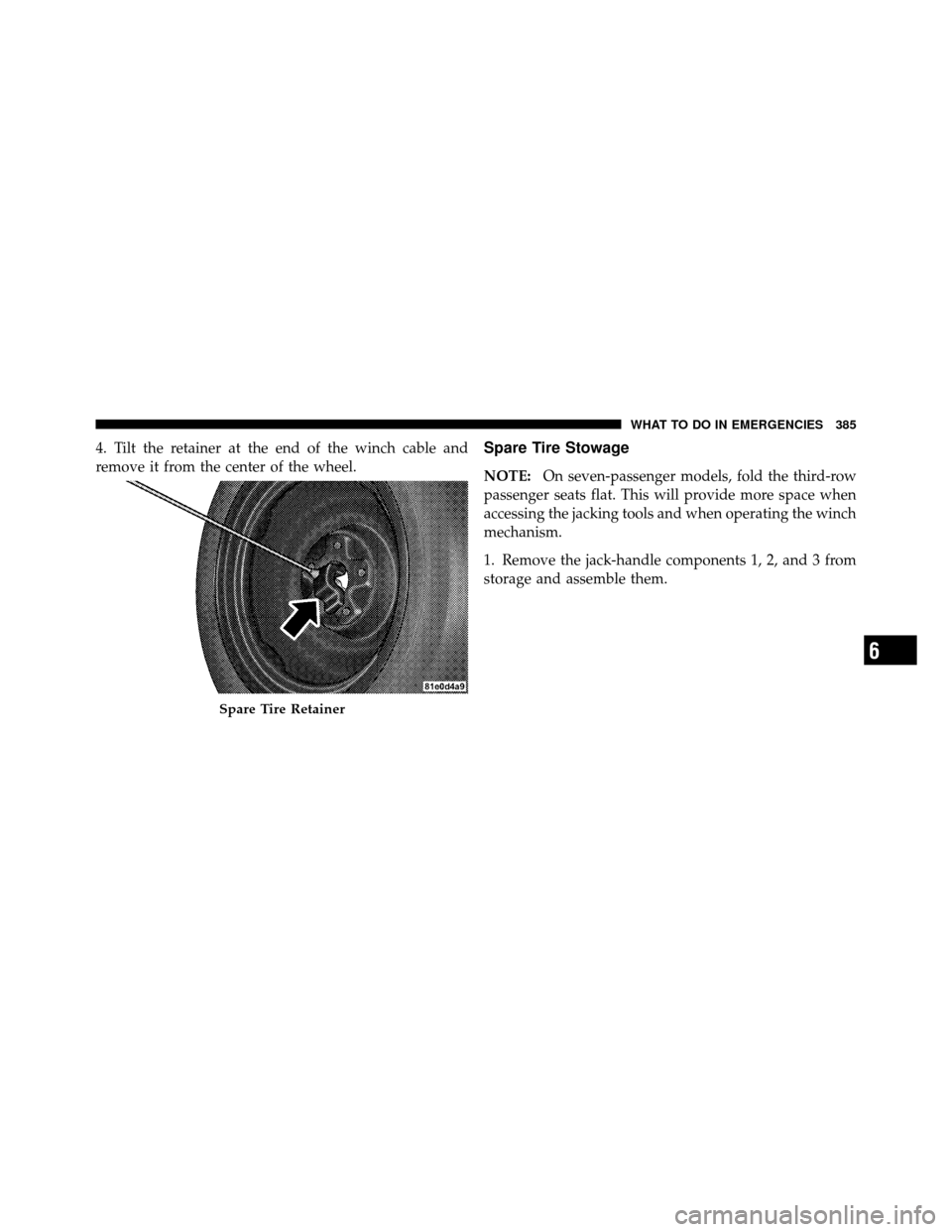
4. Tilt the retainer at the end of the winch cable and
remove it from the center of the wheel.Spare Tire Stowage
NOTE:On seven-passenger models, fold the third-row
passenger seats flat. This will provide more space when
accessing the jacking tools and when operating the winch
mechanism.
1. Remove the jack-handle components 1, 2, and 3 from
storage and assemble them.
Spare Tire Retainer
6
WHAT TO DO IN EMERGENCIES 385
Page 387 of 512
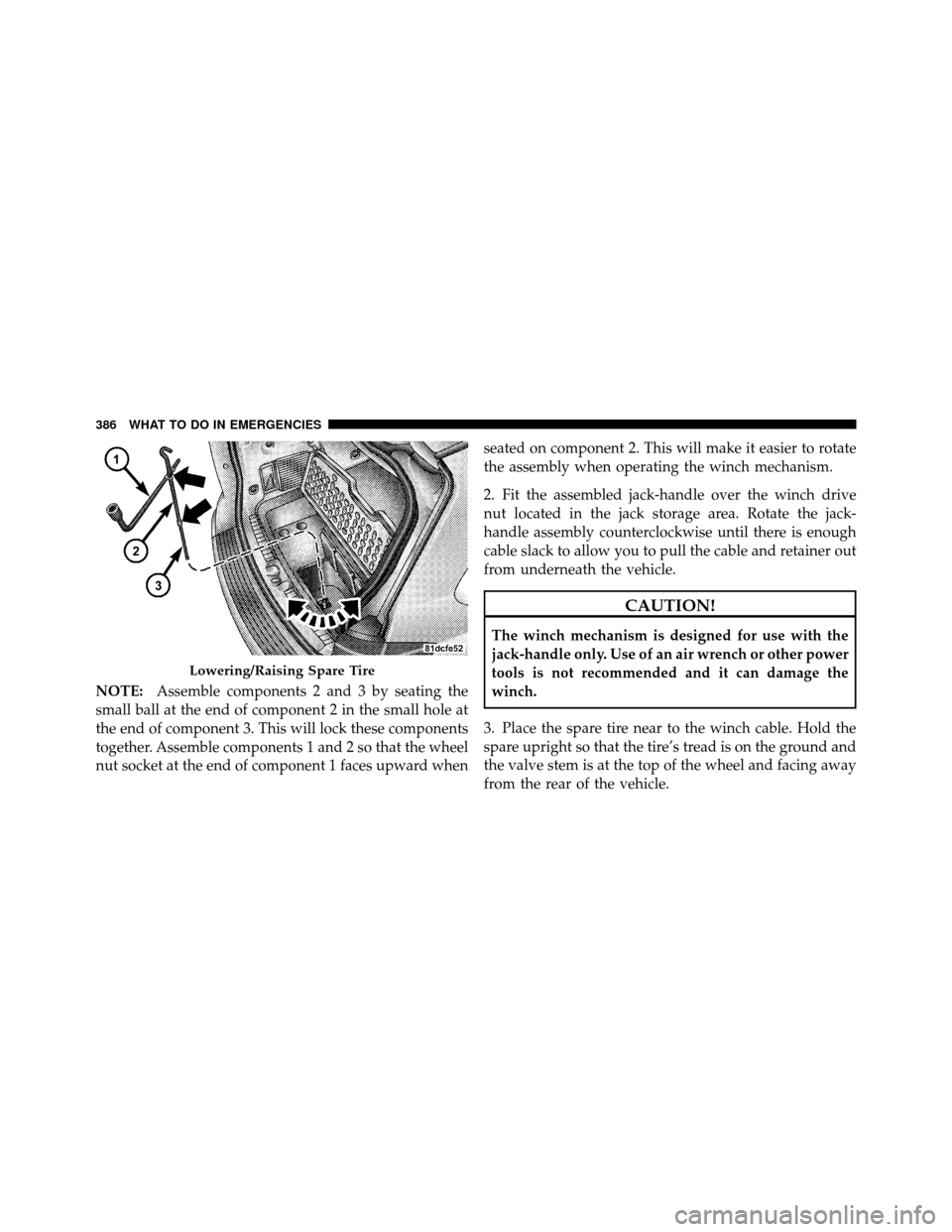
NOTE:Assemble components 2 and 3 by seating the
small ball at the end of component 2 in the small hole at
the end of component 3. This will lock these components
together. Assemble components 1 and 2 so that the wheel
nut socket at the end of component 1 faces upward when seated on component 2. This will make it easier to rotate
the assembly when operating the winch mechanism.
2. Fit the assembled jack-handle over the winch drive
nut located in the jack storage area. Rotate the jack-
handle assembly counterclockwise until there is enough
cable slack to allow you to pull the cable and retainer out
from underneath the vehicle.
CAUTION!
The winch mechanism is designed for use with the
jack-handle only. Use of an air wrench or other power
tools is not recommended and it can damage the
winch.
3. Place the spare tire near to the winch cable. Hold the
spare upright so that the tire’s tread is on the ground and
the valve stem is at the top of the wheel and facing away
from the rear of the vehicle.
Lowering/Raising Spare Tire
386 WHAT TO DO IN EMERGENCIES
Page 388 of 512
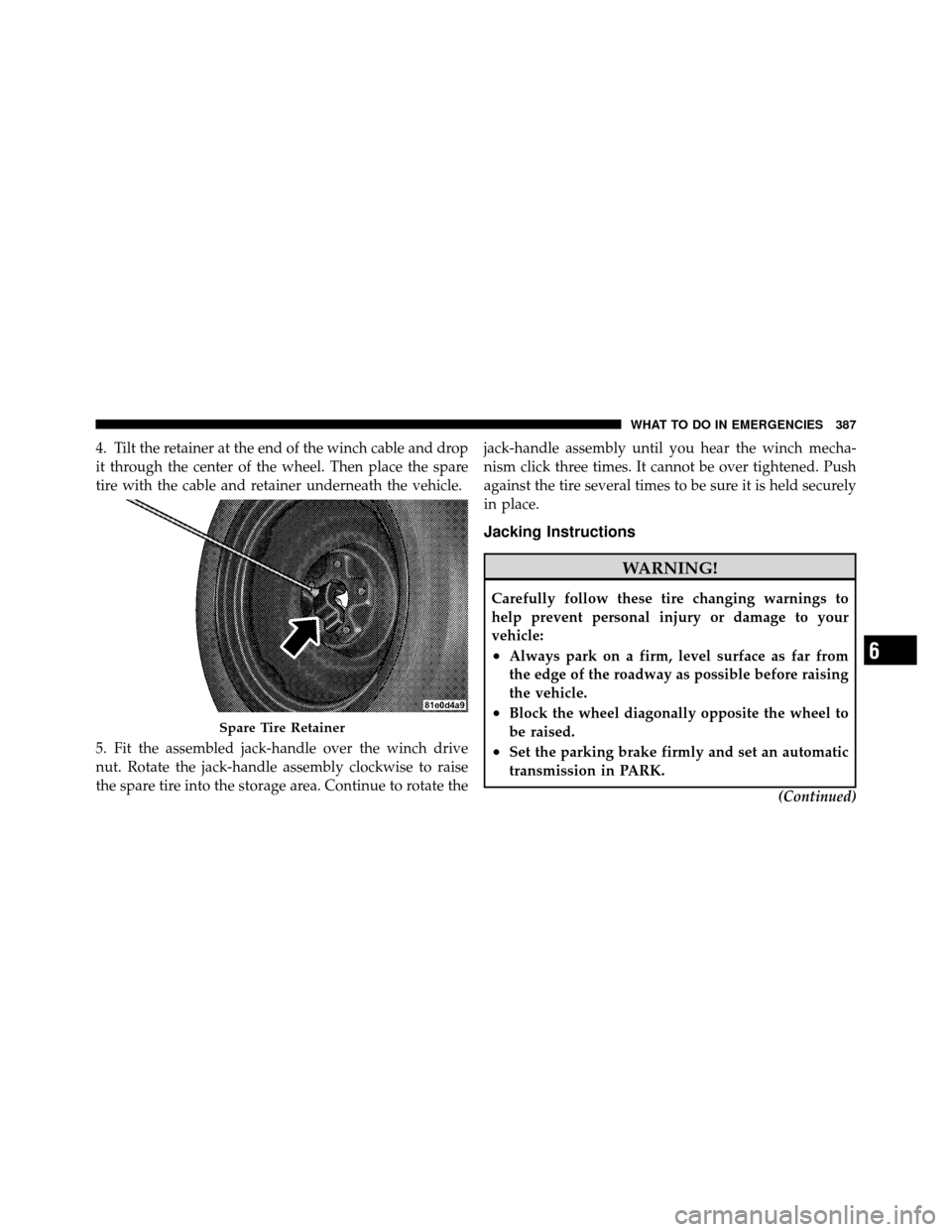
4. Tilt the retainer at the end of the winch cable and drop
it through the center of the wheel. Then place the spare
tire with the cable and retainer underneath the vehicle.
5. Fit the assembled jack-handle over the winch drive
nut. Rotate the jack-handle assembly clockwise to raise
the spare tire into the storage area. Continue to rotate thejack-handle assembly until you hear the winch mecha-
nism click three times. It cannot be over tightened. Push
against the tire several times to be sure it is held securely
in place.
Jacking Instructions
WARNING!
Carefully follow these tire changing warnings to
help prevent personal injury or damage to your
vehicle:
•Always park on a firm, level surface as far from
the edge of the roadway as possible before raising
the vehicle.
•Block the wheel diagonally opposite the wheel to
be raised.
•Set the parking brake firmly and set an automatic
transmission in PARK.
(Continued)
Spare Tire Retainer
6
WHAT TO DO IN EMERGENCIES 387
Page 389 of 512
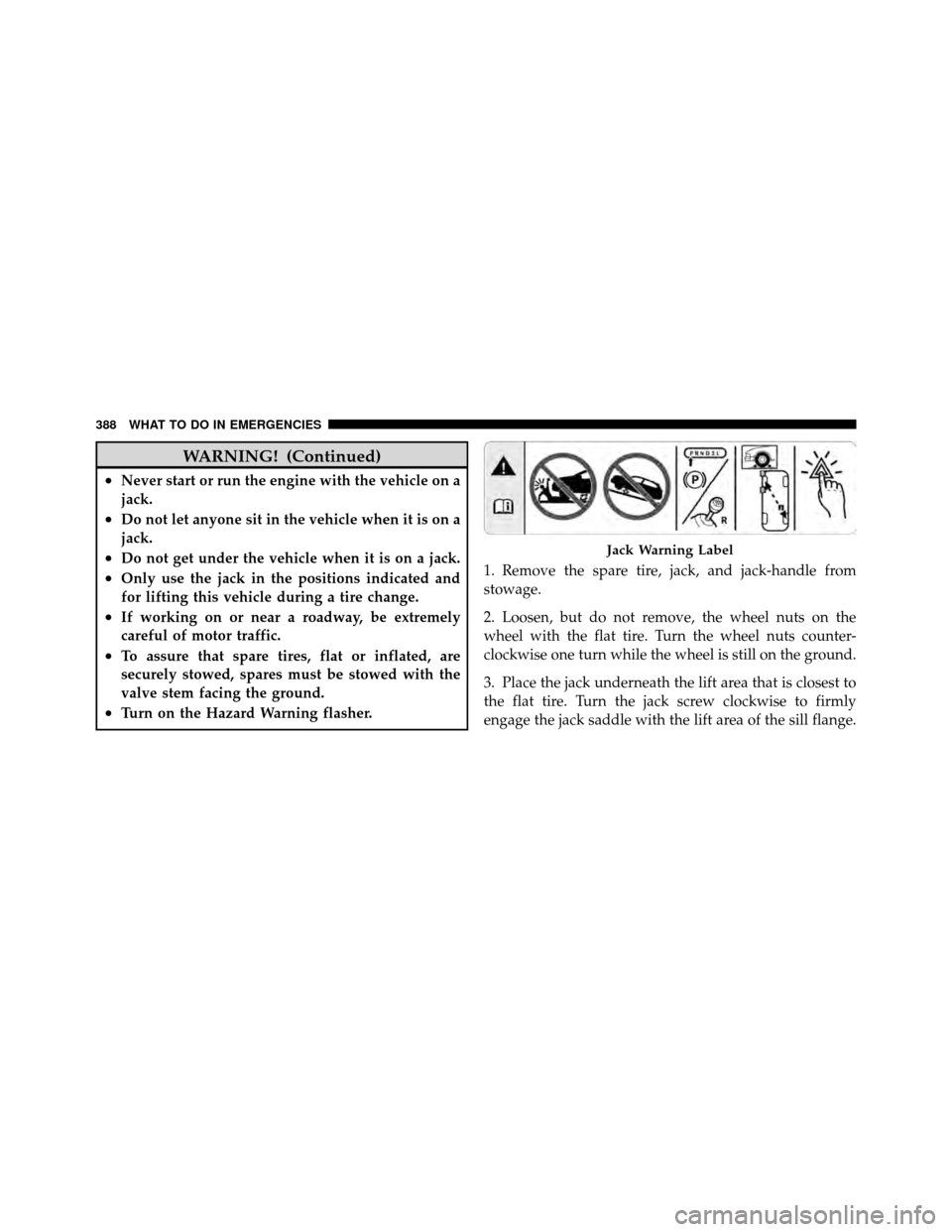
WARNING! (Continued)
•Never start or run the engine with the vehicle on a
jack.
•Do not let anyone sit in the vehicle when it is on a
jack.
•Do not get under the vehicle when it is on a jack.
•Only use the jack in the positions indicated and
for lifting this vehicle during a tire change.
•If working on or near a roadway, be extremely
careful of motor traffic.
•To assure that spare tires, flat or inflated, are
securely stowed, spares must be stowed with the
valve stem facing the ground.
•Turn on the Hazard Warning flasher.1. Remove the spare tire, jack, and jack-handle from
stowage.
2. Loosen, but do not remove, the wheel nuts on the
wheel with the flat tire. Turn the wheel nuts counter-
clockwise one turn while the wheel is still on the ground.
3. Place the jack underneath the lift area that is closest to
the flat tire. Turn the jack screw clockwise to firmly
engage the jack saddle with the lift area of the sill flange.
Jack Warning Label
388 WHAT TO DO IN EMERGENCIES
Page 390 of 512

4. Raise the vehicle by turning the jack screw clockwise
with the jack handle. Raise the vehicle until the tire just
clears the road surface and enough clearance is obtained
to install the spare tire. Minimum tire lift provides
maximum stability.
Front Jacking LocationRear Jacking Location6
WHAT TO DO IN EMERGENCIES 389